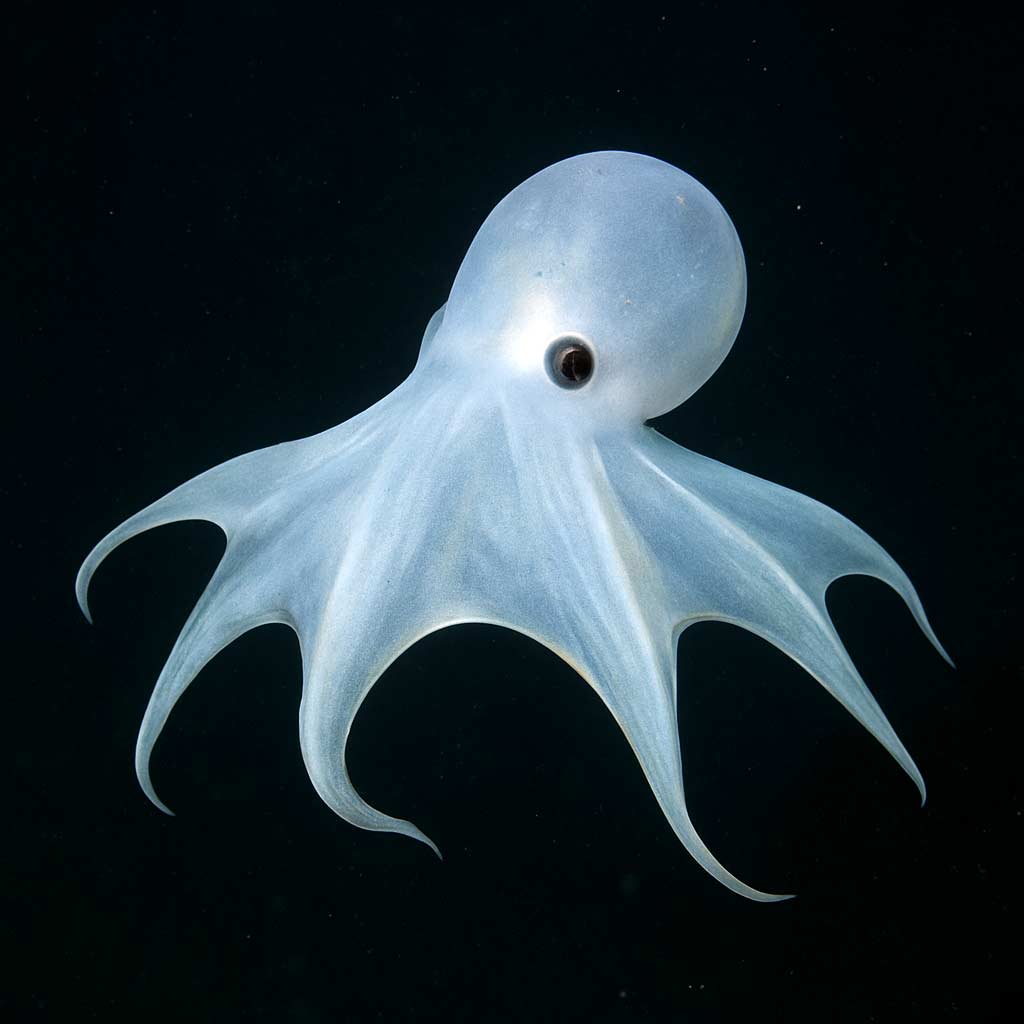Ghost of the Deep: The Allure of the Ghost Octopus
The ocean is full of mysterious creatures that seem like they were designed by a dream—or maybe a nightmare. Among them, one stands out not for its ferocity or size, but for its otherworldly grace and transparency. The ghost octopus, sometimes called the Casper octopus, is one of the most fascinating deep-sea discoveries of recent years. It’s pale, delicate, and hauntingly beautiful—almost like a living apparition drifting through the dark abyss of the ocean floor.
If you’ve ever seen Shawn McNulty’s abstract painting “Ghost Octopus”, you’ll understand the eerie elegance this creature embodies. The artwork features a soft, white ghostly form intertwined with a bold red octopus shape, a visual dialogue between spirit and substance, presence and absence. In many ways, it perfectly mirrors the real ghost octopus—an animal that exists between worlds: tangible yet ethereal, fragile yet endlessly resilient.

A Creature Discovered in the Shadows
The ghost octopus was first discovered in 2016 by NOAA scientists using a remotely operated vehicle (ROV) exploring the ocean floor near Hawaii. What they saw floating across their monitor screens looked like something out of a fairytale: a small, almost translucent octopus gliding gently just above the seabed, with no pigment and no visible fins. Unlike the colorful, shapeshifting cephalopods we’re used to seeing in shallower waters, this one appeared entirely unearthly—almost cartoonishly simple. The scientists affectionately nicknamed it Casper, after the friendly ghost, and the name stuck.
This wasn’t just an exciting find—it was an entirely new species, belonging to the genus Grimpoteuthis, which includes the adorable and better-known Dumbo octopus. But the ghost octopus lacked the signature ear-like fins of its relatives. It was something different—an elegant minimalism in motion, all soft edges and translucent curves.
The simplicity of its body is what makes it so unique. While most octopuses have chromatophores (cells that allow them to change color), this one seems to have evolved without them. Instead, it’s completely unpigmented, appearing milky white or faintly transparent. It doesn’t even have the muscular build we associate with most octopuses. Living at depths where food and light are scarce, the ghost octopus embodies efficiency and adaptation—just enough structure to survive, nothing more.
Life in the Deep
Imagine living two and a half miles below the surface of the ocean. It’s pitch-black, freezing cold, and the pressure is so intense it could crush metal. Yet somehow, this ghostly creature has made it home. The ghost octopus lives in some of the most extreme conditions on Earth, where volcanic rock meets soft sediment, and strange life forms cling to survival.

Scientists believe these octopuses lay their eggs on the stalks of dead sponges found on the ocean floor. The female wraps her delicate arms around the stalks and tends to the eggs for years—literally years—without feeding, patiently protecting her future offspring. This kind of parental devotion is rare and remarkable in the animal kingdom, and even more so in such a hostile environment. When the eggs finally hatch, the mother often dies shortly after, having given everything to her young. It’s a quiet, noble end—much like a ghost fading after its final purpose is fulfilled.
Because they live so deep, ghost octopuses are rarely seen. Most of what we know about them comes from deep-sea camera footage and a few lucky observations. They move with a soft, rhythmic grace, their arms flowing like ribbons in slow motion, as if they’re dancing in water so thick it could be silk. Watching one feels meditative—like seeing time itself move more slowly down there in the depths.
The Art and Essence of the Ghost
The ghost octopus isn’t flashy or fierce. It doesn’t squirt ink, change color, or put on dazzling camouflage displays like its shallow-water cousins. Its magic is subtler—a living poem of form and motion. And that’s exactly what makes it such a powerful muse for artists like Shawn McNulty.
McNulty’s painting “Ghost Octopus” captures this duality perfectly. The white form resembles a drifting spirit—gentle, weightless, and elusive—while the red octopus form bursts through with energy and life. Together, they form a striking contrast, much like the creature’s existence itself: life in the dark, motion in stillness, fragility in power. The painting’s abstract energy feels like an emotional translation of the ocean’s silence—the red form echoing the pulse of life that persists even where light cannot reach.
In abstract terms, “Ghost Octopus” isn’t just about a marine animal. It’s about balance—the tension between presence and absence, visibility and invisibility, the known and the unknown. The ocean, after all, mirrors the human mind in many ways: vast, mysterious, and filled with uncharted depths. The ghost octopus is a symbol of that mystery made visible, a reminder of how little we truly know about the natural world, and how beautiful that unknowing can be.
Caring for the Unknown
The discovery of the ghost octopus also carries an environmental message. The deep sea, once thought to be untouched by human activity, is now threatened by deep-sea mining and pollution. Creatures like the ghost octopus are especially vulnerable because their ecosystems are so slow to recover. It can take centuries for deep-sea coral and sponge communities to rebuild once disturbed.
By shining a light—both scientific and artistic—on such species, we gain a better appreciation for these hidden worlds. Every new discovery like the ghost octopus is a reminder that Earth still holds surprises, that life finds a way even in the most desolate places. But it’s also a reminder of our responsibility to protect what we don’t yet understand.
The ghost octopus’s transparency can even be seen as symbolic of the delicate transparency of the natural balance itself—something that can vanish if disturbed too deeply. Like McNulty’s painting, where color and form hang in fragile tension, the real-world balance between exploration and preservation must be handled with care.
The Spirit Beneath the Waves
Ultimately, what makes the ghost octopus so captivating isn’t just its appearance—it’s what it represents. It’s a creature of silence and endurance, living proof of nature’s creativity. Its calm presence in the darkest depths invites us to slow down, to look closer, and to find beauty in stillness.
Standing in front of Shawn McNulty’s “Ghost Octopus,” one can almost feel that same quiet pulse of life that exists far below the waves. The ghostly white shape becomes a vessel of mystery, while the red octopus form grounds it in the physical world. Together they remind us that even in the dark, unseen places—whether deep in the ocean or within ourselves—there’s motion, vitality, and spirit.
The ghost octopus is, in essence, a paradox: a living ghost, a fragile survivor, a minimalist masterpiece of evolution. And like McNulty’s painting, it lingers in the imagination long after you’ve looked away—a spectral reminder of how art and nature share the same heartbeat, pulsing quietly in the dark.








